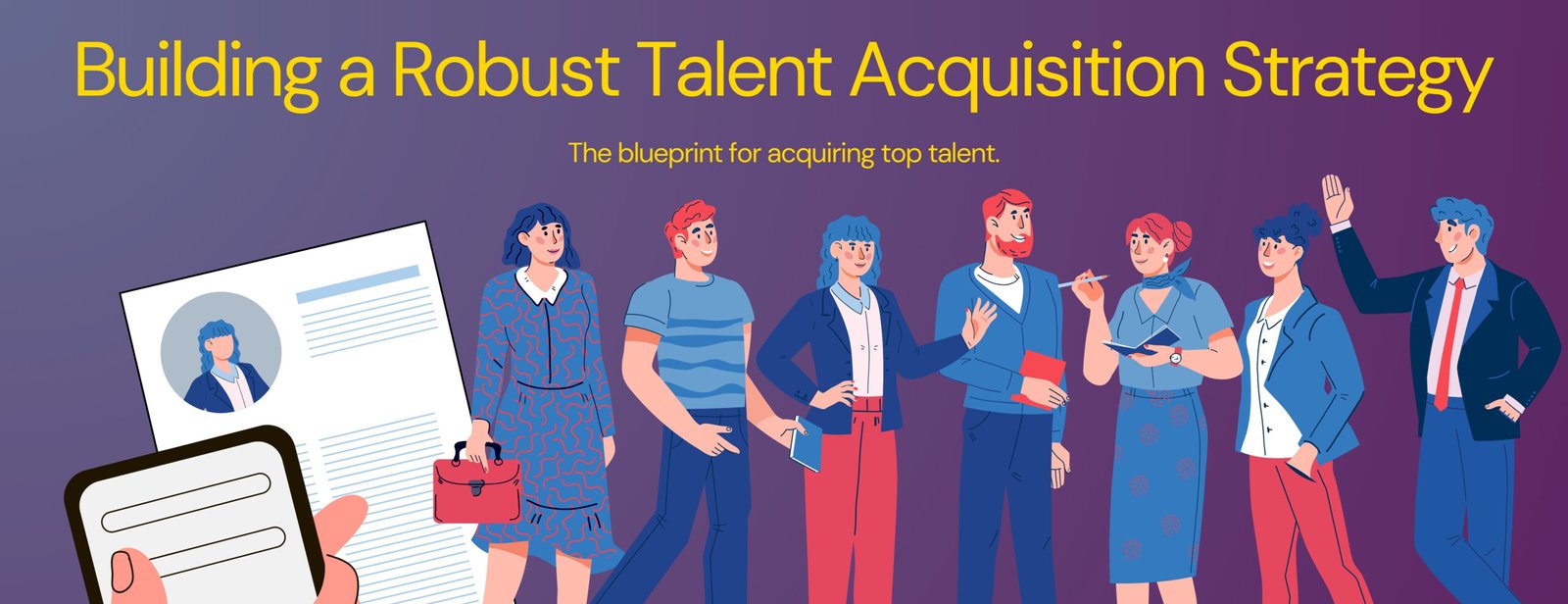Last updated:
A state-of-the-art, step-by-step guide to designing a scalable, data-driven Talent Acquisition (TA) strategy — spanning workforce planning, employer branding, candidate experience, AI & automation, DEI, analytics, and onboarding alignment.
Why Talent Acquisition Matters
- Skill shortages: Scarcity across IT, engineering, healthcare, and skilled trades raises competition and salaries.
- Brand over salary: Culture, flexibility, and purpose often outplay pure compensation in candidate decision-making.
- Tech transformation: AI-driven sourcing, programmatic ads, and predictive analytics reshape speed and quality.
- Retention begins at hiring: Better matches cut early attrition and protect productivity.
The 7 Pillars of a Robust TA Strategy
1. Workforce Planning & Alignment
- Translate business goals into role forecasts and skill maps (12–24 month horizon).
- Build scenarios (growth, steady, cost‑containment) and align budgets, channels, and SLAs accordingly.
- Tools: HR analytics, headcount planning, capacity modeling.
2. Employer Branding & EVP (Employee Value Proposition)
- Codify your EVP (mission, growth, flexibility, benefits, DEI) and apply it consistently.
- Use employee stories, short-form video, and leadership posts across LinkedIn/XING and careers pages.
- Measure brand lift via applications per posting, brand search volume, and review-site sentiment.
3. Candidate Experience
- Keep applications <5 minutes on desktop/mobile with clear progress indicators.
- Automate confirmations and timeline updates; send constructive rejections.
- Offer structured interviews and provide feedback within 48–72 hours of interviews.
4. Technology & AI in Recruitment
- Adopt an ATS as your single source of truth; integrate sourcing, assessments, background checks.
- Leverage AI for sourcing, screening, and scheduling; pilot programmatic ads and skills matching.
- Establish data governance: bias monitoring, explainability, and human-in-the-loop review.
5. Diversity, Equity & Inclusion (DEI)
- Set quarterly targets, diversify channels, and remove degree inflation where skills suffice.
- Use inclusive language checkers; train interviewers on structured, competency-based evaluation.
- Report quarterly on diversity funnel metrics and outcomes.
6. Data-Driven Decision Making
- Track Time-to-Hire, Cost-per-Hire, Quality-of-Hire, Offer Acceptance Rate, Candidate NPS.
- Run cohort analyses by role, region, and channel to reallocate budgets to top-performing sources.
- Build a live dashboard (Power BI/Tableau) for recruiters & leadership.
7. Onboarding & Retention Alignment
- Hand off cleanly from TA to HRBP/manager; start preboarding on offer acceptance.
- Use 30‑60‑90 day plans, mentoring buddies, and early pulse checks (weeks 2, 6, 12).
- Close the loop: share early attrition insights back to sourcing & selection.
2025 Trends Shaping Talent Acquisition
- AI & Automation: From sourcing to scheduling, automation shifts recruiters into consultative roles.
- Skills-based hiring: Portfolios, micro-credentials, and assessments gain weight over degrees.
- Remote/hybrid & cross-border: Wider talent pools, more compliance complexity.
- Internal mobility: Talent marketplaces surface hidden skills and reduce external spend.
- Data ethics & fairness: Clear governance for models, auditing for bias, and candidate transparency.
Step-by-Step Blueprint for TA Leaders
- Audit: Map your current funnel (source → hire). Identify bottlenecks, drop-offs, and cycle time.
- Set Goals: e.g., reduce TTH by 20%, raise offer acceptance by 10 pts, lift DEI representation by 15%.
- Select Stack: Modern ATS + sourcing tools + assessments + BI. Prioritize integrations.
- Upskill Team: Data literacy, structured interviewing, inclusive hiring, stakeholder management.
- Build Pipelines: University programs, referrals, communities, silver-medalist nurturing.
- Operate a Cadence: Weekly standups on req health; monthly reviews on channel ROI; quarterly strategy refresh.
- Measure & Iterate: A/B test job ads, interview formats, and employer-brand assets; scale what works.
Pro tip: Treat TA like product: conduct discovery with candidates & hiring managers, ship improvements in sprints, and measure outcomes.
Core KPIs & Sample Dashboard
| Metric | Definition | Typical Target | Owner |
|---|---|---|---|
| Time-to-Hire (TTH) | Days from req approval to accepted offer | -20% vs. last quarter (role-benchmarked) | Recruiting Ops |
| Quality-of-Hire (QoH) | Composite of 90-day performance, ramp time, retention | Baseline + continuous improvement | HRBP & Hiring Manager |
| Offer Acceptance Rate | Accepted offers / total offers | >80% (role & market dependent) | TA Lead |
| Candidate NPS | Candidate satisfaction with process | ≥ +40 | Recruiting Ops |
| Channel ROI | Hires / spend & time by source | Shift budget to top 3 sources | TA Lead & Finance |
Conclusion
A robust Talent Acquisition strategy is a blueprint for sustainable growth. By uniting workforce planning, employer branding, candidate experience, AI-enabled tooling, DEI, analytics, and onboarding alignment, organizations hire faster, fairer, and smarter — and retain people who thrive.
References & Further Reading
- LinkedIn Talent Solutions – Annual Hiring & Recruiting Trends (industry research)
- Gartner HR Research – Future of Recruiting & Talent Intelligence
- Deloitte Insights – Workforce Strategies and Human Capital Trends
- SHRM – Global Talent Acquisition Best Practices & Playbooks
Note: References are widely cited industry resources. Tailor with your organization’s subscribed reports and add local market data where available.
Disclaimer & Credits
Disclaimer: This article is provided for informational purposes only and does not constitute legal, financial, or HR compliance advice. While care has been taken to ensure accuracy, Excelloit Consultancy Services GmbH assumes no liability for errors, omissions, or changes in third-party tools, regulations, or market conditions. Always verify policies and laws applicable to your jurisdiction.
Drafting note: This blog was prepared with assistance from ChatGPT (OpenAI).



